Themed collection Frontiers in coordination chemistry and its applications

Frontiers in coordination chemistry and its applications
We are delighted to present this collection of articles to celebrate the work of Kim Dunbar on the occasion of her 60th birthday.

Dalton Trans., 2018,47, 11736-11738
https://doi.org/10.1039/C8DT90140F
The electrochemical reduction of a flexible Mn(II) salen-based metal–organic framework
A salen-based MOF is reported that is stable to desolvation and exhibits a crystalline-to-amorphous transition. The framework is stable to a one-electron reduction, which is characterised spectroelectrochemically and using computational calculations.

Dalton Trans., 2021,50, 12821-12825
https://doi.org/10.1039/D1DT02589A
Octacyanometallate qubit candidates
Cyanometallates are excellent building blocks for networks, we demonstrate counterintuitively long spin–lattice relaxation times in two heavy octacyanometalltes.
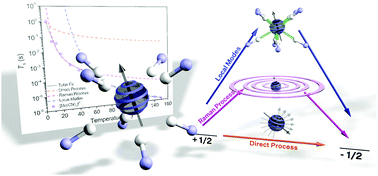
Dalton Trans., 2018,47, 11744-11748
https://doi.org/10.1039/C8DT02312C
Coordination-induced reversible electrical conductivity variation in the MOF-74 analogue Fe2(DSBDC)
DMF coordination to Fe centers induces partial electron transfer and improves electrical conductivity in Fe2(DSBDC) by three orders of magnitude.
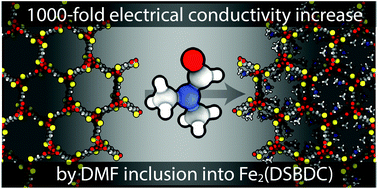
Dalton Trans., 2018,47, 11739-11743
https://doi.org/10.1039/C8DT02197J
Synthesis, characterization, X-ray and electronic structures of diethyl ether and 1,2-dimethoxyethane adducts of molybdenum(IV) chloride and tungsten(IV) chloride
Facile routes to MCl4(dme) M = Mo, W. Improved syntheses and characterizations.

Dalton Trans., 2022,51, 7856-7863
https://doi.org/10.1039/D2DT00787H
Isostructural M(II) complexes (M = Mn, Fe, Co) with field-induced slow magnetic relaxation for Mn and Co complexes
We reported the first example of SIM behavior in a hepta-coordinate pentagonal bipyramid MnII complex.

Dalton Trans., 2019,48, 12023-12030
https://doi.org/10.1039/C8DT02150C
Anionic guest-dependent slow magnetic relaxation in Co(II) tripodal iminopyridine complexes
We explore structural and magnetic changes on mononuclear cobalt(II) complex salts featuring a tripodal iminopyridine ligand imparted by second coordination sphere anions.

Dalton Trans., 2019,48, 9117-9126
https://doi.org/10.1039/C9DT00739C
A linear trinuclear ferrous single molecule magnet
A linear trinuclear ferrous [FeII3] SMM exhibited clear magnetic hysteresis loops and a significant higher effective energy barrier in comparison with its cobalt(II) analogue.

Dalton Trans., 2018,47, 16704-16708
https://doi.org/10.1039/C8DT03410A
A novel bis-1,2,4-benzothiadiazine pincer ligand: synthesis, characterization and first row transition metal complexes
The synthesis and coordination chemistry of ligand LH2 to first row transition metals is described in which it acts as a tridentate N,N′,N′′-donor.

Dalton Trans., 2018,47, 15725-15736
https://doi.org/10.1039/C8DT03346C
Magnetic properties of transition metal dimers probed by inelastic neutron scattering
We characterise the spin dynamics of two molecular transition metal dimers, by combining inelastic neutron scattering and magnetic measurements.

Dalton Trans., 2018,47, 11953-11959
https://doi.org/10.1039/C8DT02570C
Ferrocene-based anilides: synthesis, structural characterization and inhibition of butyrylcholinesterase
Twenty-three compounds in two series of ferrocene-based anilides, with the general formula C5H5-Fe-C5H4-C6H4-NH-CO-C6H4-R (where R = H, F, Cl, CH3 and OCH3), have been synthesized and found to inhibit butyrylcholinesterase.
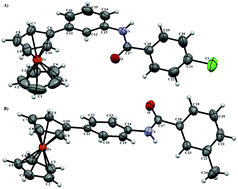
Dalton Trans., 2018,47, 11769-11781
https://doi.org/10.1039/C8DT01726C
Correlating cobalt redox couples to photovoltage in the dye-sensitized solar cell
Two sets of structurally analogous Co(III/II)-based redox mediators were incorporated in the dye-sensitized solar cells and a linear correlation was demonstrated between redox potential and photovoltage.

Dalton Trans., 2018,47, 11942-11952
https://doi.org/10.1039/C8DT01921E
Multimodal Prussian blue analogs as contrast agents for X-ray computed tomography
Heavy alkaline cation uptake converts Prussian blue analogs (PBAs) into competitive contrast agents for X-ray computed tomography.
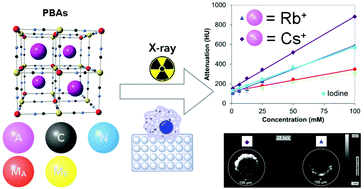
Dalton Trans., 2018,47, 11960-11967
https://doi.org/10.1039/C8DT01687A
Heterometallic Cu/Ln cluster chemistry: ferromagnetically-coupled {Cu4Ln2} complexes exhibiting single-molecule magnetism and magnetocaloric properties
A new family of ferromagnetically-coupled {Cu4Ln2} complexes is reported. The compounds exhibit SMM and magnetocaloric properties.

Dalton Trans., 2018,47, 11934-11941
https://doi.org/10.1039/C8DT01780H
Rationalizing the sign and magnitude of the magnetic coupling and anisotropy in dinuclear manganese(III) complexes
Combined experimental and theoretical studies on a family of twelve MnIII dimers reveal that exchange contribution to the magnetic anisotropy is as important as single ion anisotropy.
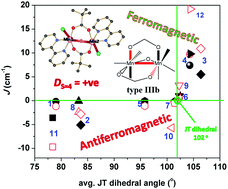
Dalton Trans., 2018,47, 11820-11833
https://doi.org/10.1039/C8DT01410H
Layered ferrimagnets constructed from charge-transferred paddlewheel [Ru2] units and TCNQ derivatives: the importance of interlayer translational distance in determining magnetic ground state
In D2A-type layered magnets composed of paddlewheel-type diruthenium(II,II) complexes and TCNQ derivatives, is it a ferrimagnet or an antiferromagnet?
![Graphical abstract: Layered ferrimagnets constructed from charge-transferred paddlewheel [Ru2] units and TCNQ derivatives: the importance of interlayer translational distance in determining magnetic ground state](/en/Image/Get?imageInfo.ImageType=GA&imageInfo.ImageIdentifier.ManuscriptID=C8DT01566J&imageInfo.ImageIdentifier.Year=2018)
Dalton Trans., 2018,47, 11760-11768
https://doi.org/10.1039/C8DT01566J
Magnetic layered perovskites of [CH3C(NH2)2]2[M(HCOO)4] (M = Co2+ and Ni2+): synthesis, structures and properties
Two layered perovskites of the formula [CH3C(NH2)2]2[M(HCOO)4] (M = Co and Ni) exhibit anisotropic thermal expansion behavior and weak ferromagnetism.
![Graphical abstract: Magnetic layered perovskites of [CH3C(NH2)2]2[M(HCOO)4] (M = Co2+ and Ni2+): synthesis, structures and properties](/en/Image/Get?imageInfo.ImageType=GA&imageInfo.ImageIdentifier.ManuscriptID=C8DT01729H&imageInfo.ImageIdentifier.Year=2018)
Dalton Trans., 2018,47, 11925-11933
https://doi.org/10.1039/C8DT01729H
A bromo-capped diruthenium(I,I) N-heterocyclic carbene compound for in situ bromine generation with NBS: catalytic olefin aziridination reactions
A bromo-capped diruthenium(I,I) complex activates NBS to produce bromine in situ, and thus catalyses bromine-mediated olefin aziridination reactions.

Dalton Trans., 2018,47, 11917-11924
https://doi.org/10.1039/C8DT01851K
A fluorescent layered oxalato-based canted antiferromagnet
The first fluorescent oxalato-based canted antiferromagnet maintains the quantum nature of the emitters thanks to the isolation provided by the honeycomb matrix.
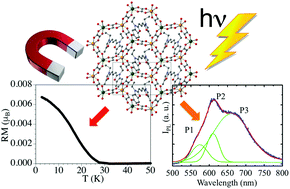
Dalton Trans., 2018,47, 11909-11916
https://doi.org/10.1039/C8DT01473F
Oxygen activation at a dicobalt centre of a dipyridylethane naphthyridine complex
The mechanism of oxygen activation at a dicobalt bis-μ-hydroxo core is probed by the implementation of synthetic methods to isolate reaction intermediates.
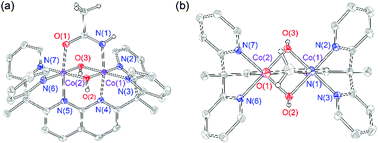
Dalton Trans., 2018,47, 11903-11908
https://doi.org/10.1039/C8DT01598H
Bridging cyanides from cyanoiron metalloligands to redox-active dinitrosyl iron units
Cyanide, as an ambidentate ligand, plays a pivotal role in providing a simple diatomic building-block motif, for controlled metal aggregation, M–CN–M′.
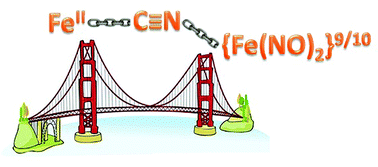
Dalton Trans., 2018,47, 11812-11819
https://doi.org/10.1039/C8DT01761A
Tuning the spin crossover behavior of the polyanion [(H2O)6Fe3(μ-L)6]6–: the case of the cesium salt
Cation exchange transforms the gradual spin transition of the trimer [(H2O)6Fe3(μ-L)6]6– into an abrupt transition with a wide hysteresis above room temperature.
![Graphical abstract: Tuning the spin crossover behavior of the polyanion [(H2O)6Fe3(μ-L)6]6–: the case of the cesium salt](/en/Image/Get?imageInfo.ImageType=GA&imageInfo.ImageIdentifier.ManuscriptID=C8DT01339J&imageInfo.ImageIdentifier.Year=2018)
Dalton Trans., 2018,47, 11895-11902
https://doi.org/10.1039/C8DT01339J
Direct synthesis of functionalized PCN-333 via linker design for Fe3+ detection in aqueous media
Functionalized PCN-333 was synthesized for Fe3+ ion detection via one-pot solvothermal reaction.
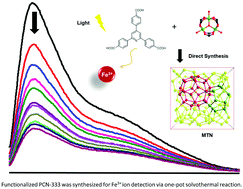
Dalton Trans., 2018,47, 11806-11811
https://doi.org/10.1039/C8DT01508B
Heptamolybdate: a highly active sulfide oxygenation catalyst
[Mo2O11]2− identified as the active species in H2O2 oxygenation of sulfides catalyzed by heptamolybdate using in situ nano-ESI MS analysis.

Dalton Trans., 2018,47, 11882-11887
https://doi.org/10.1039/C8DT00583D
Cross-linking of cyanide magnetic coordination polymers by rational insertion of formate, cyanide or azide
Anionic bridging ligands formate, cyanide and azide have been used to form cross-links in a ferrimagnetic coordination framework, resulting in competing magnetic interactions that decrease the magnetic ordering temperature and result in peculiar magnetic properties.

Dalton Trans., 2018,47, 11888-11894
https://doi.org/10.1039/C8DT01513A
Electrically switchable magnetic exchange in the vibronic model of linear mixed valence triferrocenium complex
A vibronic model for the electric field control of antiferromagnetic exchange is developed for the linear mixed-valence triferrocenium complex Fe(III)–Fe(II)–Fe(III), which is proposed as possible molecular candidate for the implementation of a quantum logic gate.

Dalton Trans., 2018,47, 11788-11805
https://doi.org/10.1039/C8DT01386A
Substituents drive ligand rearrangements, giving dinuclear rather than mononuclear complexes, and tune CoII/III redox potential
Sterically encumbered 6-halo-substituents lead to BF4/MeOH/ligand rearrangement, forming doubly bridged {Co1–[O(Me)–B(F2)–O(R)]2–Co1A} dinuclear complexes (6-Cl, 6-Br) of the modified ligands.
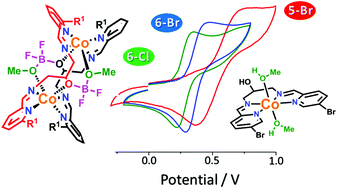
Dalton Trans., 2018,47, 11749-11759
https://doi.org/10.1039/C8DT01502C
Slow magnetic relaxation and luminescence properties in lanthanide(III)/anil complexes
The Dy(III) member of a family of lanthanide(III)-anil complexes displays luminescence and exhibits slow magnetic relaxation.
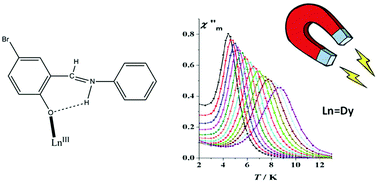
Dalton Trans., 2018,47, 11859-11872
https://doi.org/10.1039/C8DT01264D
New Ru(II) complex for dual photochemotherapy: release of cathepsin K inhibitor and 1O2 production
A new Ru(II) complex releases a cysteine protease inhibitor and produces cytotoxic 1O2 upon irradiation with visible light, making it potentially useful as a dual-action PDT agent.

Dalton Trans., 2018,47, 11851-11858
https://doi.org/10.1039/C8DT00876K
Syntheses, structures, and magnetic properties of three new MnII–[MoIII(CN)7]4− molecular magnets
Three cyanide-bridged 3D long-range magnetic ordering complexes were successfully synthesized and magnetically characterized. These compounds are the first [MoIII(CN)7]4−-based materials containing the bidentate secondary ligands.
![Graphical abstract: Syntheses, structures, and magnetic properties of three new MnII–[MoIII(CN)7]4− molecular magnets](/en/Image/Get?imageInfo.ImageType=GA&imageInfo.ImageIdentifier.ManuscriptID=C8DT01433G&imageInfo.ImageIdentifier.Year=2018)
Dalton Trans., 2018,47, 11873-11881
https://doi.org/10.1039/C8DT01433G
Influence of the catalyst structure in the cycloaddition of isocyanates to oxiranes promoted by tetraarylstibonium cations
In the context of our work on electron deficient group 15 cations as Lewis acid catalysts, we have synthesized the triflate salts of a series of tetraarylstibonium cations and evaluated their catalytic activity for the cycloaddition of isocyanates to oxiranes.
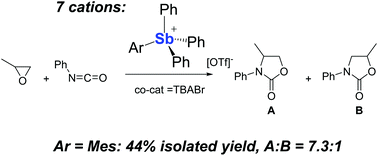
Dalton Trans., 2018,47, 11843-11850
https://doi.org/10.1039/C8DT00702K
Order in disorder: solution and solid-state studies of [MIII2MII5] wheels (MIII = Cr, Al; MII = Ni, Zn)
Heterometallic species with Anderson-like structures are characterised by single-crystal X-ray diffraction, solution- and solid-state NMR spectroscopy, ESI mass spectrometry and SQUID magnetometry.
![Graphical abstract: Order in disorder: solution and solid-state studies of [MIII2MII5] wheels (MIII = Cr, Al; MII = Ni, Zn)](/en/Image/Get?imageInfo.ImageType=GA&imageInfo.ImageIdentifier.ManuscriptID=C8DT00685G&imageInfo.ImageIdentifier.Year=2018)
Dalton Trans., 2018,47, 11834-11842
https://doi.org/10.1039/C8DT00685G
A nitrogen-rich ligand as a scaffold for slow magnetic relaxation in dysprosium-based 0D and 1D architectures
A nitrogen-rich ligand is employed as a scaffold for lanthanide ions, leading to clear SMM-like behaviour and two well-isolated modes of magnetic relaxation.
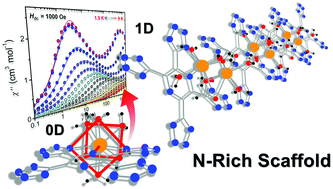
Dalton Trans., 2018,47, 11782-11787
https://doi.org/10.1039/C8DT00146D
About this collection
This special issue of Dalton Transactions is to mark the 60th birthday of mentor, friend and colleague, Professor Kim R. Dunbar.
The issue highlights emerging trends in coordination chemistry, reflecting the many diverse areas of where Kim’s work has impacted the field of inorganic chemistry. Examples include, but are not limited to, molecular magnetism, structure, spectroscopy, photochemistry, supramolecular chemistry, metals in medicine, and anion-pi interactions.